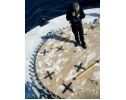3D measurement of rotor blades
Having information about the effective surfaces of rotor blades and turbines is vital in order to control and optimize production processes.
Optical measurement technology from GOM can be used to verify the shape and dimensions of rotor blades, pointwise or across the entire surface, against CAD or master data.
The measured data can also be used in reverse engineering to create a copy of an optimal rotor.
Inspection of mounting surfaces on wind power plant
The individual components of wind power units often only come together just before assembly on-site.
The portable TRITOP measuring system can be used to measure and inspect mounting bolts and surfaces in less than one hour. This is also possible for off-shore foundations and structures. Thus, mounting bolts that are not in the correct position can be identified and adjusted before construction begins. This ensures smooth assembly of wind power plants without the risk of additional costs or delays.
Bending fatigue test for rotor blades
Rotor blades are subject to high stress on account of their weight and the force of irregular winds. They therefore undergo comprehensive bench tests to verify their operational stability and strength. Their behavior is analyzed under normal to shear stress conditions as well as in the bending fatigue test. For precise analysis of strain and deformation on rotor blade surfaces, the mobile and flexible optical measuring systems from GOM can be integrated quickly and easily in rotor blade test stands. This provides valuable information about the behavior and robustness of rotor blades, including local strain and deformation data. The optical 3D data is also useful in verification of simulation calculation models and enables the continuous optimization of wind power units.
Dynamic deformation analysis of wind power units in running operation
Dynamic online deformation measuring systems from GOM are standard tools for analyzing and visualizing deformation on aerodynamically loaded structures. This technology is also used to analyze the entire structure of wind energy plants to enable modal analysis and monitoring of vibration characteristics while units are in operation. Acceleration, deformation (torsion, bending, etc.) and the angular position of the rotor blades are all analyzed, along with vibrations in the entire unit and deflection of the tower due to wind forces and emergency braking.

